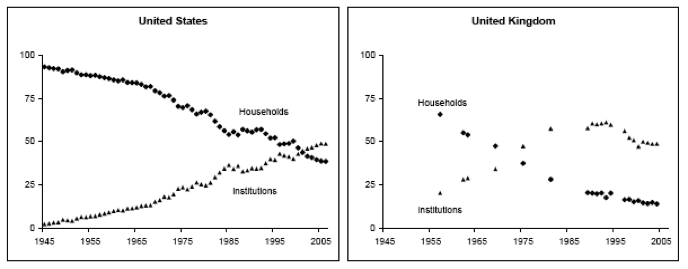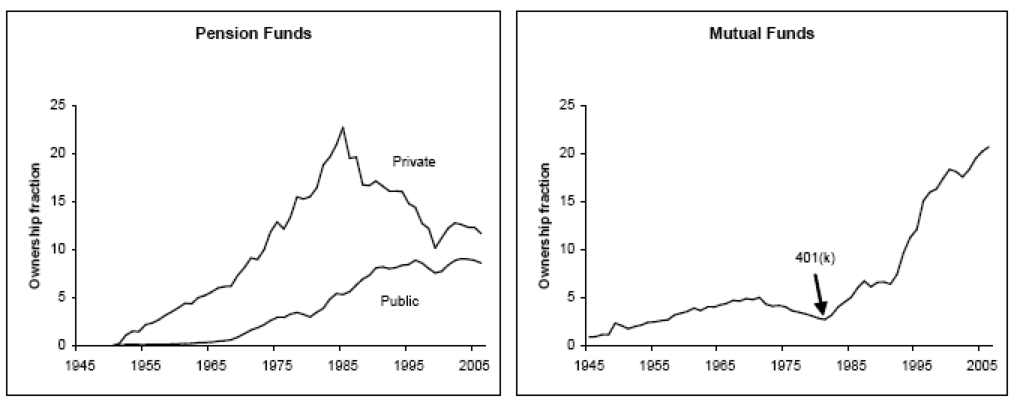Stock ownership and tax policy
Since World War II, direct stock ownership by households has largely been replaced by indirect stock ownership by financial institutions. This column argues that tax policy drove that shift.
Search the site
Since World War II, direct stock ownership by households has largely been replaced by indirect stock ownership by financial institutions. This column argues that tax policy drove that shift.
In Pensions, Economics, and Public Policy, Richard Ippolito (1986) argued that tax policy changed the ownership structure of the US stock market. He pointed out that retirement savings are favoured by the tax code. Investment returns inside a pension plan accrue tax-free, whereas dividends and capital gains on directly held stocks are subject to personal income tax. In addition, employers and employees can contribute pre-tax dollars, which means that households can reduce their marginal tax rates by shifting taxable income from high-income work years to low-income retirement years. As a result of these tax benefits, direct stock ownership by households has gradually shifted to tax-favoured pension plans. In recent research (Rydqvist, Spizman, and Strebulaev 2009), we provide evidence that tax policy indeed has changed the aggregate stock ownership structure in this way.
Stock ownership data from the US and UK appear consistent with this prediction. As we can see to the left in Figure 1, households owned more than 90% of the US stock market right after World War II compared to less than 30% in 2006. The ownership data in the plot to the right, however sparse, suggests that a similar evolution of stock ownership has occurred in the UK. A large portion of households' ownership shares have migrated to financial intermediaries that manage private pension plans such as pension funds, mutual funds, and life insurance companies. In fact, a similar shift of ownership shares from households to carriers of retirement assets has taken place in all countries for which long time-series of stock ownership data exist. There is not a single developed country where households own more than half of the equity market directly – the average across countries is just 17%.
Figure 1. Evolution of aggregate stock ownership

The figure shows the aggregate fraction of household direct ownership of equity (diamonds) and the aggregate fraction held by pension funds, mutual funds, and insurance companies (triangles). The data sources are Flow of Funds (US), Revell and Moyle (1966), Moyle (1971), and Statistics UK.
The evolution of stock ownership within the group of financial institutions also supports the importance of tax policy. Figure 2 plots the evolution of the stock ownership shares of pension funds and mutual funds in the US. Pension funds began to grow after World War II when effective tax rates became high, and mutual funds did not begin to grow until they were granted the tax status of pension funds in 1982 (401(k) plan).
Figure 2. Stock ownership of US mutual funds and pension funds

The two figures show the stock ownership fractions of private and public pension funds and of mutual funds in percent of all stocks. The figure for mutual funds also marks the introduction of 401(k) plans in 1982. Source: Flow of Funds.
The US and the UK suffered from high inflation in the 1970s and early 1980s. Personal income tax tables were nominally fixed, and inflation pushed many households into higher income tax brackets approaching the statutory maxima of 70% in the US and 83% in the UK. Thus, households rapidly divested out of the stock market to escape the near confiscatory taxation of dividends and capital gains. In Sweden, households divested at a rate of two percentage points per year during the high-inflation period. The experience of these three countries contrasts with Germany and Japan, where the change in stock ownership structure did not accelerate in the 1970s and the 1980s, due to tight monetary policy and low effective tax rates, respectively.
From this evidence, we conclude that the proliferation of financial intermediaries in the stock market is the likely consequence of tax policy. Stock prices would have been much lower without the dynamic tax clientele shift that we have observed. Ownership structure also matters to current and future debates on capital income taxation. Capital income is concentrated in the wealthiest fraction of the population, which is therefore a natural target group for tax policy changes. However, as ownership shares have migrated from wealthy households to untaxed private pension plans, further manipulation of capital income taxation of stocks is increasingly less relevant.
Ippolito, Richard (1986), Pensions, Economics, and Public Policy, The Pension Research Council, Philadelphia.
Rydqvist, Kristian, Joshua Spizman, and Ilya Strebulaev (2009), “The Evolution of Aggregate Stock Ownership---A Unified Explanation”, CEPR Discussion Paper 7356.
840 Reads